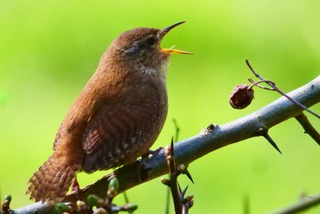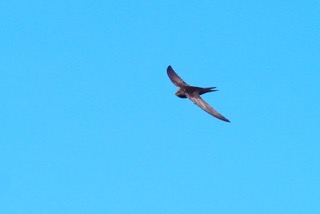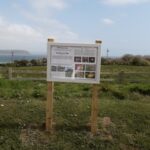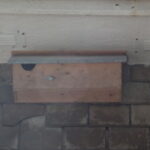 Dawn Chorus
Dawn Chorus
May, a time to look forward to better days. First, rise with the wren at 4.45am on Sunday, May 2nd for International Dawn Chorus Day; and listen to the cacophony of birdsong as it reaches its height for the season. Melinsey Mill through the deciduous woodland down the Pendower Valley or Messack wood near the ancient oak tree are both good spots to try. Or, if this is too early for you, listen to the Evening Chorus, just as lovely but usually less of a full orchestra with more of the soloists, including, if you are lucky, screaming swifts, which I refer to later.
During the afternoon, venture to Kiberick Cove, follow the coast path towards Nare Head and take in the burbling and strange laughing noises of the guillemot colony and the razorbills, and the other seabirds breeding on the Gull Rock offshore.
Swifts Return
 An early swift was seen in Tregony by Karen McEndoo on the 25th of April, and another on site by Alayne Bowditch on the 27th, A very good sign, as usually they are not around until the second week in May.
An early swift was seen in Tregony by Karen McEndoo on the 25th of April, and another on site by Alayne Bowditch on the 27th, A very good sign, as usually they are not around until the second week in May.
Look for dark scythe shapes, a little larger than swallows, and listen to swifts screaming as they come in from around 12000ft from south of the Sahara; our last migrant breeder to arrive, yet first to leave by early August. Amazing birds, they rarely land on the ground as their extremely long wings and noticeably short legs make it too difficult.
They never perch, as their toes face side on to their legs and not forward! Although the peregrine falcon is fastest in a dive at around 240mph, swifts are the fastest level flight bird known to us in the UK, measured at more than 70mph. The male and female are identical, apart from their calls, and they mate for life, for between 10 and 20 years.
Their nests are almost always in the eaves of old, tall buildings. Locally, as far as I know they favour Portscatho, Treworga and Tregony. Newer dwellings are not usually attractive to them, as modern designs do not generally have access at eave level, hence the importance of swift nest boxes to help them to continue here as a species. The material to make their nests is all gathered in flight, usually composing of bits of paper, straw, hay, feathers and seeds, congealed together with the swift’s saliva.
The birds have 1 clutch, usually from 2 to 4 eggs; and the young are fed on regurgitated insect balls, from the 3 to 4 thousand insects estimated to be caught by the adults in flight each day! So, there is another reason why their status and numbers are dropping. It is not just modern buildings; it is also the persistent use of insecticides and pesticides which is reducing their food supply. Once the young swifts leave the nest, dropping into the air and using their huge wings for the first time, they are on their own.
The screaming I referred to earlier is interesting. Sometimes they are called devil birds, presumably because of this. My own theory is that they are known to be infested with wingless bloodsucking flies called kegs which torment them from chick to adult; and perhaps this is the reason they scream! Swifts eat, sleep, mate and migrate in the air, only landing at their chosen new breeding site, an old building, or very occasionally a tall tree. Someone calculated that every 4 years each swift will have flown a million miles. And this bird is not related to the swallow or house martin. Remarkably its closest family relative is the hummingbird.
No Mow May
The warmer temperatures bring out the need to continue to breed in the world of birds, mammals, reptiles, invertebrates, amphibians, fish, shore and pond life. Habitat becomes colourful with flowers, grasses, plants, blossom on trees and bushes; and accompanying pollen and nectar create an explosion of life amongst the myriads of insects. These in turn are both pollinators themselves and food for the warblers, swallows and other insect eating creatures like the common lizard, you may see sunning on stones, if you are lucky.

So far this year it has been great for butterflies, with records of holly blues, peacocks, red admirals, large whites, orange tips, brimstone, tortoiseshell, small copper and even painted lady all being observed locally. “No Mow May” should help them too if you can spare part of your lawn or verge to remain uncut. You can also take part in Plantlife’s “Every Flower Counts” survey taking place at the end of May (22nd – 31st May)
Please watch out for hedgehogs if you are strimming or mowing. And bird nests in hedges.
Continued Projects
 Our wild flower projects continue at Veryan, Gerrans, Portscatho, and Ruan with the generous and much appreciated help of volunteers. A new Wild Roseland wild flower information board has been put up at the Treloan car park illustrating our work with Gerrans School.
Our wild flower projects continue at Veryan, Gerrans, Portscatho, and Ruan with the generous and much appreciated help of volunteers. A new Wild Roseland wild flower information board has been put up at the Treloan car park illustrating our work with Gerrans School.
Our barn owl survey also continues during the breeding season, and the BTO monthly bird count of wetland, river and seabirds (WeBS) is also now well established.
However, if you are interested and wish to participate in any of these, you would be more than welcome to join us. Drop an email to Simon for the wild flower project: – simonperry21@gmail.com, or to myself for both the barn owl project and WeBS project: – hallruan@aol.com
We will keep you informed as other projects come out of hibernation!
Looking even further ahead, bearing in mind that Covid may hopefully not affect them, we have a full programme of evening events from September onwards already planned.
Projects for May
 A DIY project while your lawn mower is resting, make your own swift nest box, follow plans provided by RSPB or buy one if you prefer.
A DIY project while your lawn mower is resting, make your own swift nest box, follow plans provided by RSPB or buy one if you prefer.
Thank you for your continued support of Wild Roseland
David Hall.
Article by: David Hall
Photos: Jane Lewarne (Singing Wren and Swift), Colin Hastings (Swift box) Simon Perry (Wild Roseland sign) and David Hall (Dragonfly and Bluebells)

